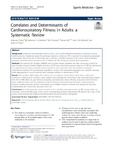Correlates and Determinants of Cardiorespiratory Fitness in Adults: a Systematic Review
Zeiher, Johannes
Ombrellaro, Katherine J.
Perumal, Nita
Keil, Thomas
Mensink, Gert B. M.
Finger, Jonas D.
Background
Enhanced cardiorespiratory fitness (CRF) is now a well-established predictor of numerous adverse health outcomes. Knowledge about the pathways leading to enhanced CRF is essential for developing appropriate interventions. Hence, the aim of this review was to provide a detailed overview of the current state of research regarding individual factors associated with or influencing CRF among the general adult population.
Methods
We searched the PubMed, EMBASE, and Cochrane Library databases and also conducted a search for grey literature (Google Scholar). Eligible indicators of CRF were objectively assessed measures of CRF by submaximal or maximal exercise testing measured using treadmill or cycle ergometer tests. We included quantitative observational studies of the general adult population. Using a semi-quantitative approach, we compiled summary tables aggregating the study results for each potential correlate or determinant of CRF.
Results
We identified 3005 studies, 78 of which met the inclusion criteria. Almost all of these studies were conducted in high-income countries. Study quality scores assessing the risk of bias in the individual studies ranged from 40 to 100%. Male sex, age (inverse), education, socioeconomic status, ethnicity, body mass index (inverse), body weight (inverse), waist circumference, body fat (inverse), resting heart rate (inverse), C-reactive protein (inverse), smoking (inverse), alcohol consumption, and multiple measures of leisure-time physical activity were independently and consistently associated with CRF.
Conclusions
In synthesizing the current research on the correlates and determinants of CRF among adults, this systematic review identified gaps in the current understanding of factors influencing CRF. Beyond the scope of this review, environmental and interpersonal determinants should be further investigated.
Dateien zu dieser Publikation

